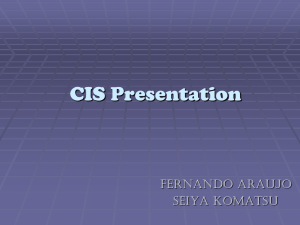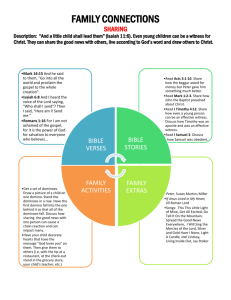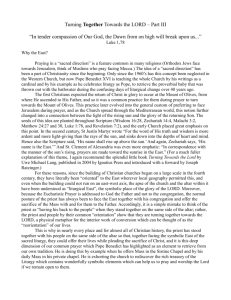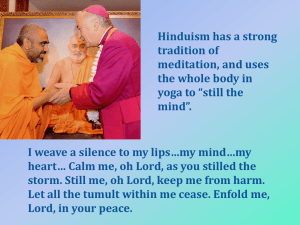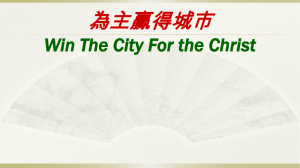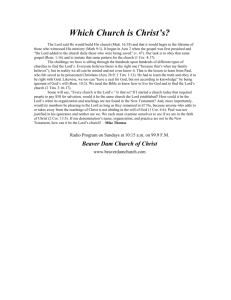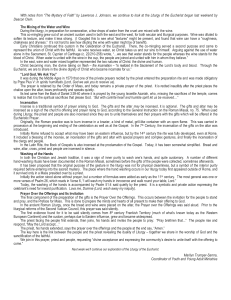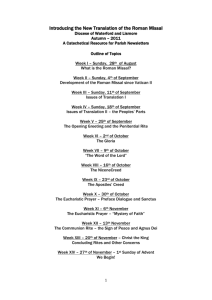Make me white, O Lord, and cleanse my heart
advertisement
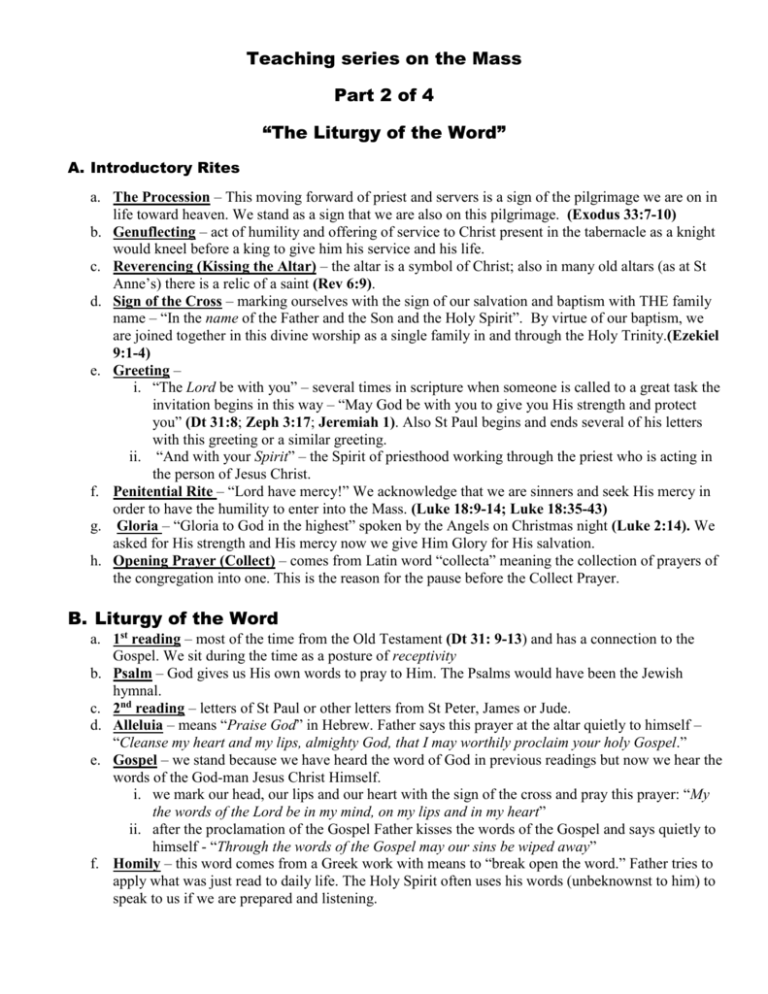
Teaching series on the Mass Part 2 of 4 “The Liturgy of the Word” A. Introductory Rites a. The Procession – This moving forward of priest and servers is a sign of the pilgrimage we are on in life toward heaven. We stand as a sign that we are also on this pilgrimage. (Exodus 33:7-10) b. Genuflecting – act of humility and offering of service to Christ present in the tabernacle as a knight would kneel before a king to give him his service and his life. c. Reverencing (Kissing the Altar) – the altar is a symbol of Christ; also in many old altars (as at St Anne’s) there is a relic of a saint (Rev 6:9). d. Sign of the Cross – marking ourselves with the sign of our salvation and baptism with THE family name – “In the name of the Father and the Son and the Holy Spirit”. By virtue of our baptism, we are joined together in this divine worship as a single family in and through the Holy Trinity.(Ezekiel 9:1-4) e. Greeting – i. “The Lord be with you” – several times in scripture when someone is called to a great task the invitation begins in this way – “May God be with you to give you His strength and protect you” (Dt 31:8; Zeph 3:17; Jeremiah 1). Also St Paul begins and ends several of his letters with this greeting or a similar greeting. ii. “And with your Spirit” – the Spirit of priesthood working through the priest who is acting in the person of Jesus Christ. f. Penitential Rite – “Lord have mercy!” We acknowledge that we are sinners and seek His mercy in order to have the humility to enter into the Mass. (Luke 18:9-14; Luke 18:35-43) g. Gloria – “Gloria to God in the highest” spoken by the Angels on Christmas night (Luke 2:14). We asked for His strength and His mercy now we give Him Glory for His salvation. h. Opening Prayer (Collect) – comes from Latin word “collecta” meaning the collection of prayers of the congregation into one. This is the reason for the pause before the Collect Prayer. B. Liturgy of the Word a. 1st reading – most of the time from the Old Testament (Dt 31: 9-13) and has a connection to the Gospel. We sit during the time as a posture of receptivity b. Psalm – God gives us His own words to pray to Him. The Psalms would have been the Jewish hymnal. c. 2nd reading – letters of St Paul or other letters from St Peter, James or Jude. d. Alleluia – means “Praise God” in Hebrew. Father says this prayer at the altar quietly to himself – “Cleanse my heart and my lips, almighty God, that I may worthily proclaim your holy Gospel.” e. Gospel – we stand because we have heard the word of God in previous readings but now we hear the words of the God-man Jesus Christ Himself. i. we mark our head, our lips and our heart with the sign of the cross and pray this prayer: “My the words of the Lord be in my mind, on my lips and in my heart” ii. after the proclamation of the Gospel Father kisses the words of the Gospel and says quietly to himself - “Through the words of the Gospel may our sins be wiped away” f. Homily – this word comes from a Greek work with means to “break open the word.” Father tries to apply what was just read to daily life. The Holy Spirit often uses his words (unbeknownst to him) to speak to us if we are prepared and listening. g. Creed – this word comes from the Latin word “Credo” which means “I believe.” But to say this “I believe” is not just to say “I believe in something that has no effect on my life” but “I believe in something that I place my whole life in.” h. Prayers of the Faithful – we unit our prayers together as God’s faithful. We usually pray for the Church, then the country or culture, then ourselves and own needs and lastly we pray for all those who have died. Why and what is father wearing at mass? The priest wears vestments because he is literally “hiding himself” because he is now acting in the person of Jesus Christ. We can say he is “clothing himself with Christ, our high priest” The Amice – comes from a Latin root word meaning “cloak” or “to wrap around.” This represents the “helmet of salvation” and is to keep all of his collar covered. Father prays this prayer as he puts it on - Place upon me, O Lord, the helmet of salvation, that I may overcome the assaults of the devil. The Alb – comes from a Latin root word meaning “white.” This represents his baptismal garment. In the Book of Revelation chapter 6 St John sees a vision of heaven and those around the throne of God wearing white garments. Father prays this prayer as he puts this on - Make me white, O Lord, and cleanse my heart; that being made white in the Blood of the Lamb I may deserve an eternal reward The cincture – Latin root word for “belt.” Represents his call to live out chastity and purity as Christ did. Father prays this prayer as he puts in on – Gird me, O Lord, with the cincture of purity, and quench in my heart the fire of concupiscence, that the virtue of continence and chastity may abide in me. The chasuble and stole – The stole represents the authority of Christ and the power of the priesthood. Father prays this prayer as he places it on Lord, restore the stole of immortality, which I lost through the collusion of our first parents, and, unworthy as I am to approach Thy sacred mysteries, may I yet gain eternal joy The chasuble represents the charity of Christ this is why it is placed on top of everything. Father says this prayer before putting it on – “O Lord, who has said, ‘My yoke is sweet and My burden light,’ grant that I may so carry it as to merit Thy grace)”

